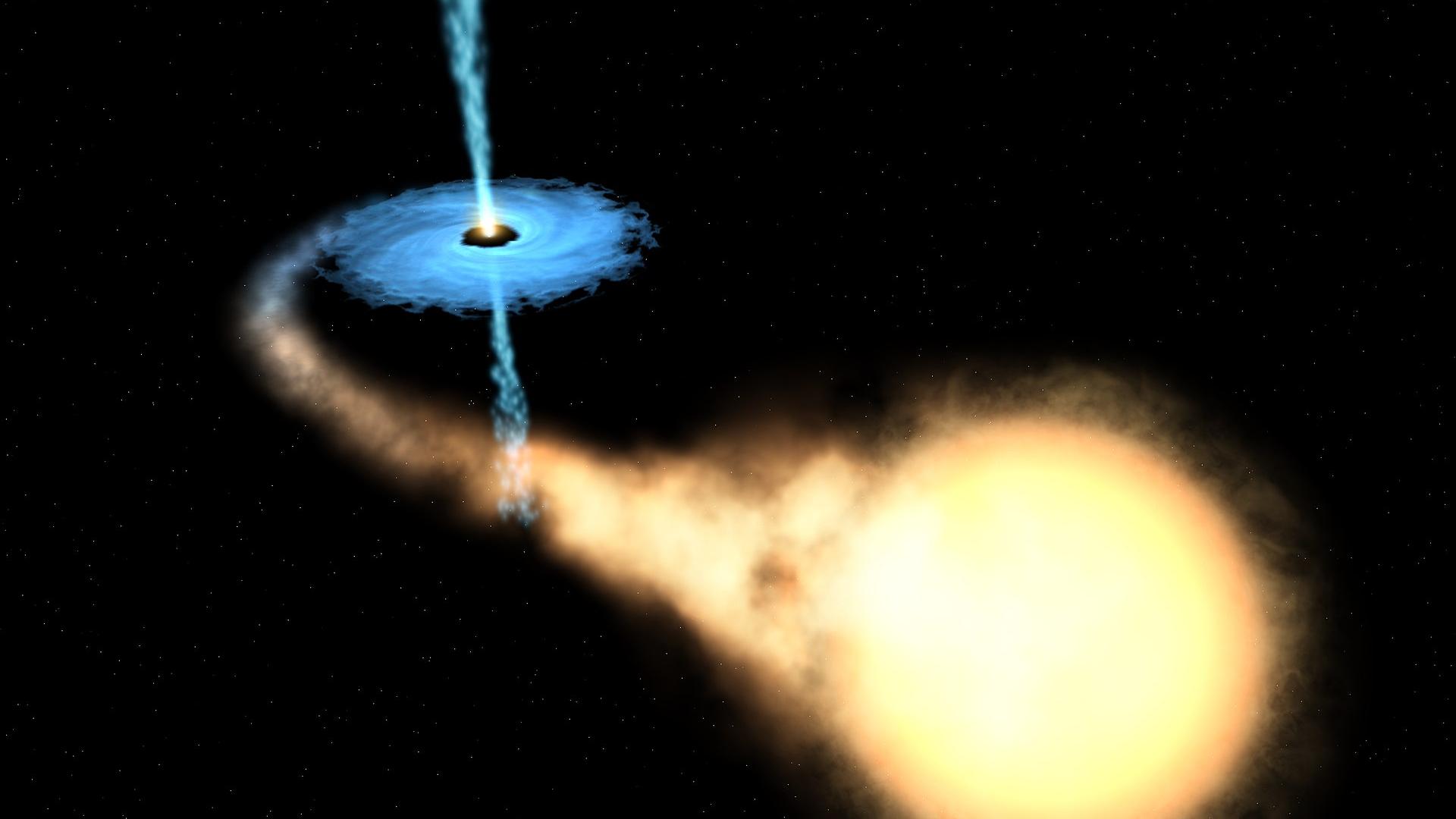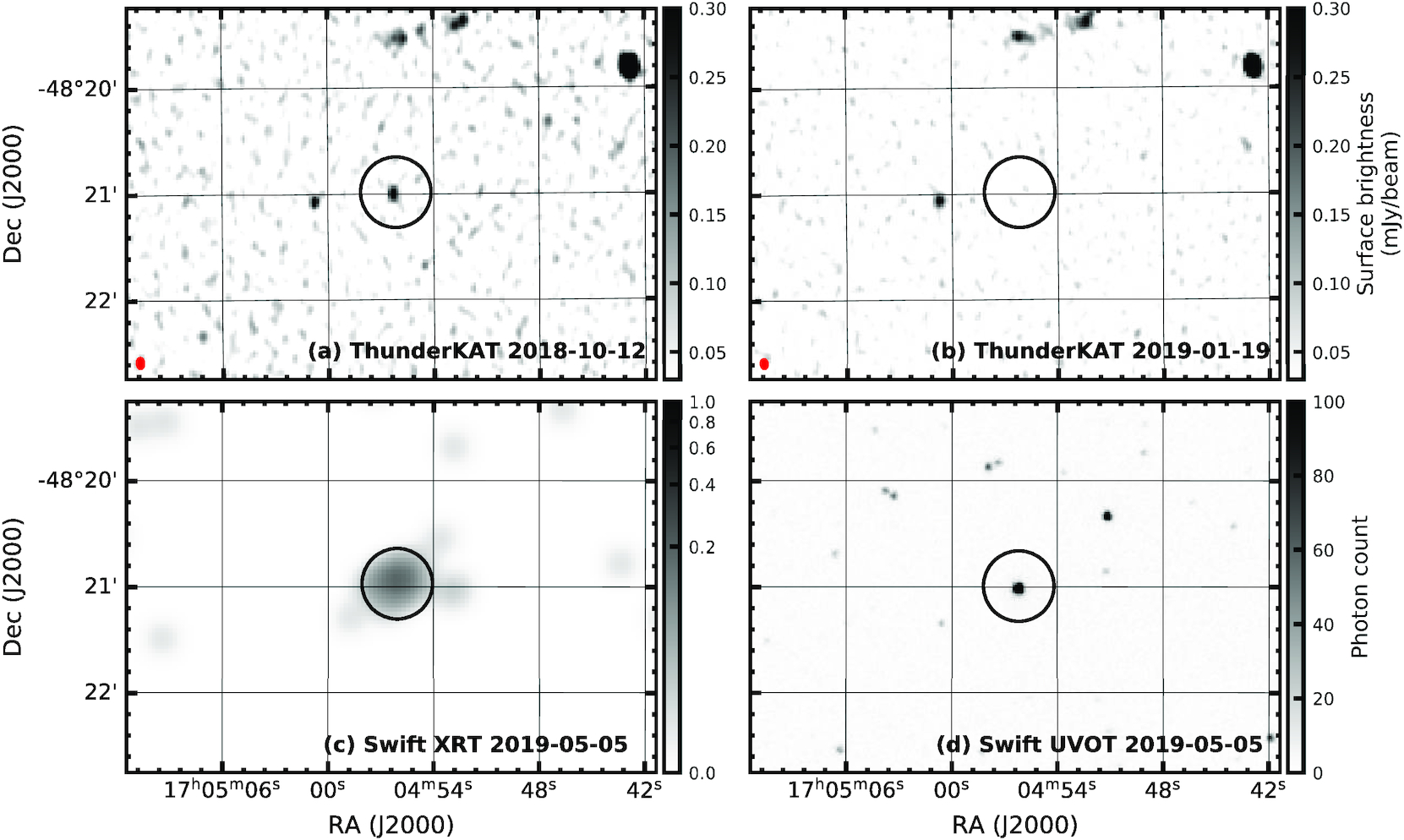Black Holes and Neutron Stars
Extreme astrophysical events – such as relativistic flows, cataclysmic explosions and black hole
accretion – are a key area for astrophysics in the 21st century. The extremes of physics – density,
temperature, pressure, velocity, gravitational and magnetic fields – experienced in these environments
are beyond anything achievable in any laboratory on Earth, and provide a unique glimpse at the laws of
physics operating in extraordinary regimes.
Black holes and neutron stars, the remnants of the most massive stars, lie at heart of these phenomena. In this group we perform world-leading observational and theoretical research into their nature, and the behaviour of matter close to them.

Artist's impression of an X-ray binary system. A more or less normal star (~yellow) yields some of the mass from its outer layers to the gravitational attraction of a neutron star (NS) or black hole (BH) with which it is bound in a binary system. Material spirals down towards the tiny NS/BH, forming a hot accretion disc and outflowing relativistic jets (~blue). These systems are small-scale analogs of the supermassive black holes found in active galactic nuclei. Credit: By ESA, NASA, and Felix Mirabel - Hubble Site, Public Domain, https://commons.wikimedia.org/w/index.php?curid=78156.
Accretion
Accretion is the process whereby matter descends into the extreme gravitational potential of a neutron star or black hole, releasing vast amounts of gravitational potential energy. For 'stellar-mass' black holes and neutron stars, most of this energy is released very close (within a few 10s of km) of the central object, producing copious X-ray emission which we study with orbiting observatories (such as Swift, Chandra and XMM). During some accretion 'states', whose nature we have led the understanding of, a relativistic jet is formed which, in contrast, is strongest in the radio band: we study these with radio telescopes such as MeerKAT and - soon - the SKA.
Because angular momentum tends to be conserved and is lost from the gas only very slowly, the accretion process is generally mediated via disc-like structures. These rotationally supported accretion discs are tremendously rich and fascinating objects. By careful study of the emission from such discs across the electromagnetic spectrum, it is possible to deduce fundamental properties of their host central mass, either a neutron star stellar remnant or a collapsed black hole. There is a strong and productive interaction between the theory and observational groups pursuing accretion studies at Oxford.
Transients
Astrophysical Transients are short-lived bursts of electromagnetic radiation, gravitational waves and/or particles which are usually associated with some of the most extreme conditions in the universe, such as black hole accretion, neutron stars, supernovae resulting from the collapse of massive stars, and neutron star merger events such as the LIGO burst source GW170817.
In Oxford we have a broad expertise in observing such transients, gained from decades of targeted study of extreme phenomena, and are heavily engaged in wide-field surveys for serendipitous field transients, in particular in the radio band. We perform these searches in wide-field data from the MeerKAT radio telescope which were originally taken for different purposes: hence, these are 'commensal' science results from the original data.
Radio observations typically allow us to study the kinetic feedback from such events, via the synchrotron emission from the shocks they produce in the surrounding medium, in ways which are largely impossible with optical observations. Only by combining optical, radio and other multi-messenger information, can we produce a complete physical picture of the physics associated with these explosions.
In some cases of astrophysical transients, such as gamma-ray bursts, from some viewing angles only late-time radio emission can be seen, as the early-time gamma-rays are beamed (relativistic aberration) out of our line of sight.

The field of transients is driven, at present, by the huge advances in optical survey speed and depth, and will be transformed by the arrival of the Rubin-LSST in 2022/23.
Pulsars
Pulsars are neutron stars that can be observed by virtue of pulsed signals in timeseries data across the electromagnetic spectrum (from radio frequencies up to Gamma rays). Pulsar allow for exciting experiments in physics due to their extreme properties. These range from super dense interiors that allow us to probe a unique configuration of cold and dense matter, to very strong inferred magnetic fields that cannot be reproduced in the lab. Neutron stars are massive and spin fast, therefore pulsar signals are very regular and can be used to measure the properties of spacetime both in the surroundings of pulsars and in the intervening medium.
The Oxford pulsar group concentrate their work on radio pulsars, as well as X-rays and Gamma-rays. The group specialize in:
- understanding the diverse population of pulsars and the birth rate and evolution of pulsars from radio, X-ray, and Gamma-ray data
- understanding the radio emission mechanism to best interpret pulsar radio signals
- understanding the geometry of pulsars through radio polarimetry as well as constraints from X-ray and Gamma-ray data
- understanding the effects of the interstellar medium on radio pulsar data
- understanding the temporal variability of pulsar signals on timescales of days to decades, and its connection to the emission mechanism and pulsar interiors
- understanding the connections between single pulse phenomenology in pulsars and Fast Radio Bursts
These topics and more are discussed regularly at Pulsar Coffee, that occurs on Tuesdays at 11am UK time during term time. Contact Aris Karastergiou if you would like details of how to join.
The group also have co-lead the software development for Pulsar and Fast Transient Searches with the Square Kilometre Array.
